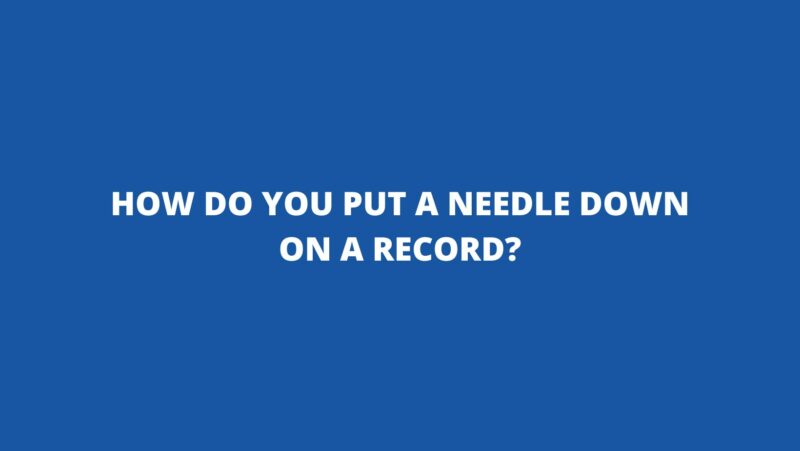Vinyl records are a beloved format for listening to music. They offer a warm, analog sound that is not possible with digital formats. However, vinyl records can be fragile, and it is important to handle them with care. One of the most important things to do when playing a vinyl record is to properly put the needle on the record.
Here are the steps involved in putting a needle down on a record:
- Prepare your turntable. Make sure that your turntable is turned off and unplugged. Place your vinyl record on the platter, with the label side facing down.
- Position the tonearm. The tonearm is the arm that holds the needle. It should be positioned so that the needle is directly over the outer grooves of the record.
- Lower the needle. There are two ways to lower the needle:
- Gently lower the tonearm by hand.
- Use the cue lever, if your turntable has one. The cue lever is a small lever that raises and lowers the tonearm.
How to Lower the Needle by Hand
To lower the needle by hand, follow these steps:
- Place your index finger and thumb on the tonearm, just above the needle.
- Gently lower the tonearm until the needle is resting on the record.
- Be careful not to drop the needle.
How to Use the Cue Lever
If your turntable has a cue lever, follow these steps to lower the needle:
- Lift the cue lever.
- The tonearm will automatically lower until the needle is resting on the record.
- Once the needle is in place, lower the cue lever.
Common Mistakes to Avoid
Here are some common mistakes to avoid when putting the needle down on a record player:
- Dropping the needle. This can damage the record and the needle.
- Touching the needle with your fingers. This can also damage the record.
- Not positioning the tonearm correctly. This can cause the needle to skip or damage the record.
- Not using a stylus guard. A stylus guard is a small piece of plastic that covers the needle when it’s not in use. This can help to protect the needle from damage.
Conclusion
By following these simple steps, you can safely and properly put the needle down on a record player and enjoy your favorite music.
Additional Tips
Here are some additional tips for putting the needle down on a record player:
- If you are using a vintage turntable, it may be helpful to have it serviced by a qualified technician. This will help to ensure that the turntable is in good working order and that the needle is properly aligned.
- Always clean your records before playing them. This will help to remove dust and dirt that could damage the needle.
- If you are playing a record that is particularly valuable or fragile, you may want to use a record clamp. A record clamp is a device that holds the record in place, preventing it from moving around.
- If you are playing a record that is very old or has been damaged, you may want to use a felt pad under the needle. This will help to protect the record from further damage.
With a little care and attention, you can enjoy your vinyl records for many years to come.
Here are some additional details that you can add to your article:
- The type of needle you use will affect the sound quality of your records. A high-quality needle will produce better sound than a low-quality needle.
- You should replace your needle regularly, especially if you play your records frequently. A worn-out needle can damage your records.
- The speed of the turntable is important. Make sure that the turntable is set to the correct speed for the record you are playing.
- The tracking force of the needle is also important. The tracking force is the amount of pressure that the needle applies to the record. The tracking force should be set according to the manufacturer’s instructions.
- If you are using a vintage turntable, it may be helpful to have it serviced by a qualified technician. This will help to ensure that the turntable is in good working order and that the needle is properly aligned.


